HRM: Analyzing Compensation Systems, Job Evaluation, and Motivation
VerifiedAdded on 2022/10/19
|8
|1810
|15
Homework Assignment
AI Summary
This assignment provides a comprehensive analysis of various aspects of Human Resource Management, focusing on employee motivation, equitable compensation systems, job evaluation methods, and the impact of pay structures on performance. It addresses the role of money as a motivator, the design of equitable compensation systems considering salary ranges and market data, and compares different job evaluation techniques like job ranking, job classification, point method, and factor comparison. The assignment further discusses the pros and cons of fixed versus variable pay methods, analyzes the responsibilities of an HR manager, and explores the benefits and challenges of performance-based pay. It also examines the drawbacks of organizational pay secrecy plans and emphasizes the importance of pay-for-performance plans in aligning organizational and employee interests. The solution draws upon various sources and theories to provide a well-rounded perspective on these critical HRM topics, providing detailed answers to assignment questions.
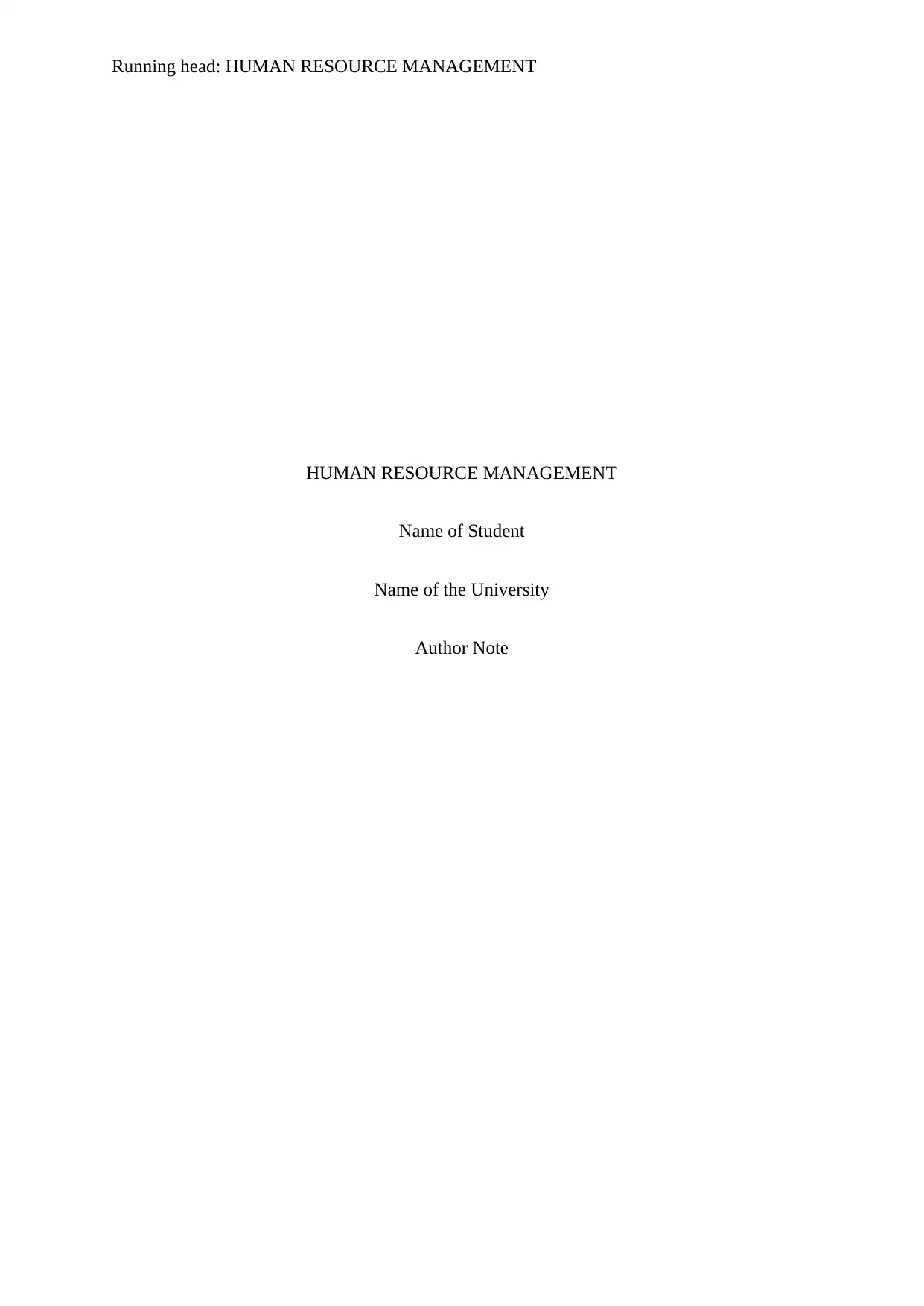
Running head: HUMAN RESOURCE MANAGEMENT
HUMAN RESOURCE MANAGEMENT
Name of Student
Name of the University
Author Note
HUMAN RESOURCE MANAGEMENT
Name of Student
Name of the University
Author Note
Paraphrase This Document
Need a fresh take? Get an instant paraphrase of this document with our AI Paraphraser
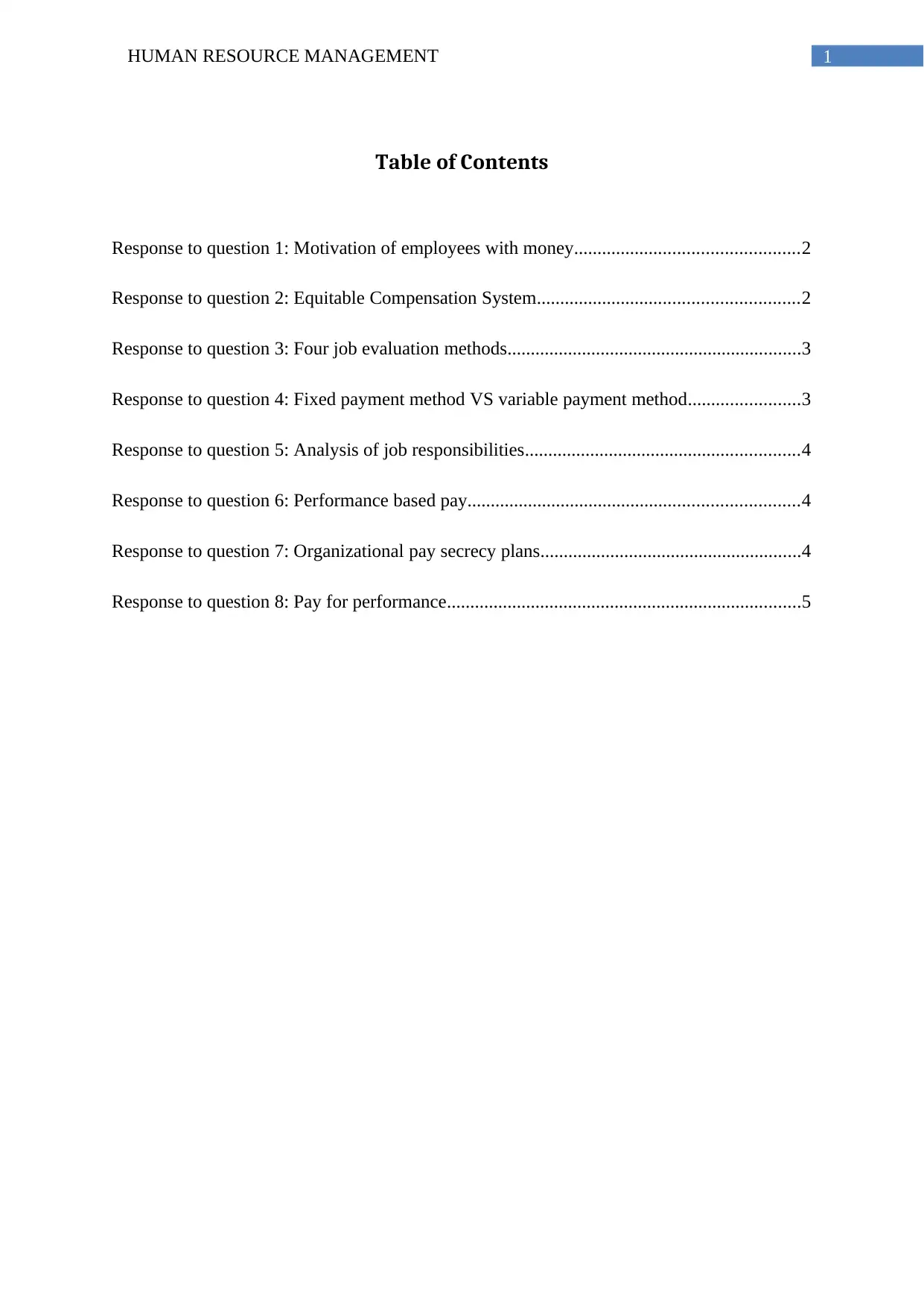
1HUMAN RESOURCE MANAGEMENT
Table of Contents
Response to question 1: Motivation of employees with money................................................2
Response to question 2: Equitable Compensation System........................................................2
Response to question 3: Four job evaluation methods...............................................................3
Response to question 4: Fixed payment method VS variable payment method........................3
Response to question 5: Analysis of job responsibilities...........................................................4
Response to question 6: Performance based pay.......................................................................4
Response to question 7: Organizational pay secrecy plans........................................................4
Response to question 8: Pay for performance............................................................................5
Table of Contents
Response to question 1: Motivation of employees with money................................................2
Response to question 2: Equitable Compensation System........................................................2
Response to question 3: Four job evaluation methods...............................................................3
Response to question 4: Fixed payment method VS variable payment method........................3
Response to question 5: Analysis of job responsibilities...........................................................4
Response to question 6: Performance based pay.......................................................................4
Response to question 7: Organizational pay secrecy plans........................................................4
Response to question 8: Pay for performance............................................................................5
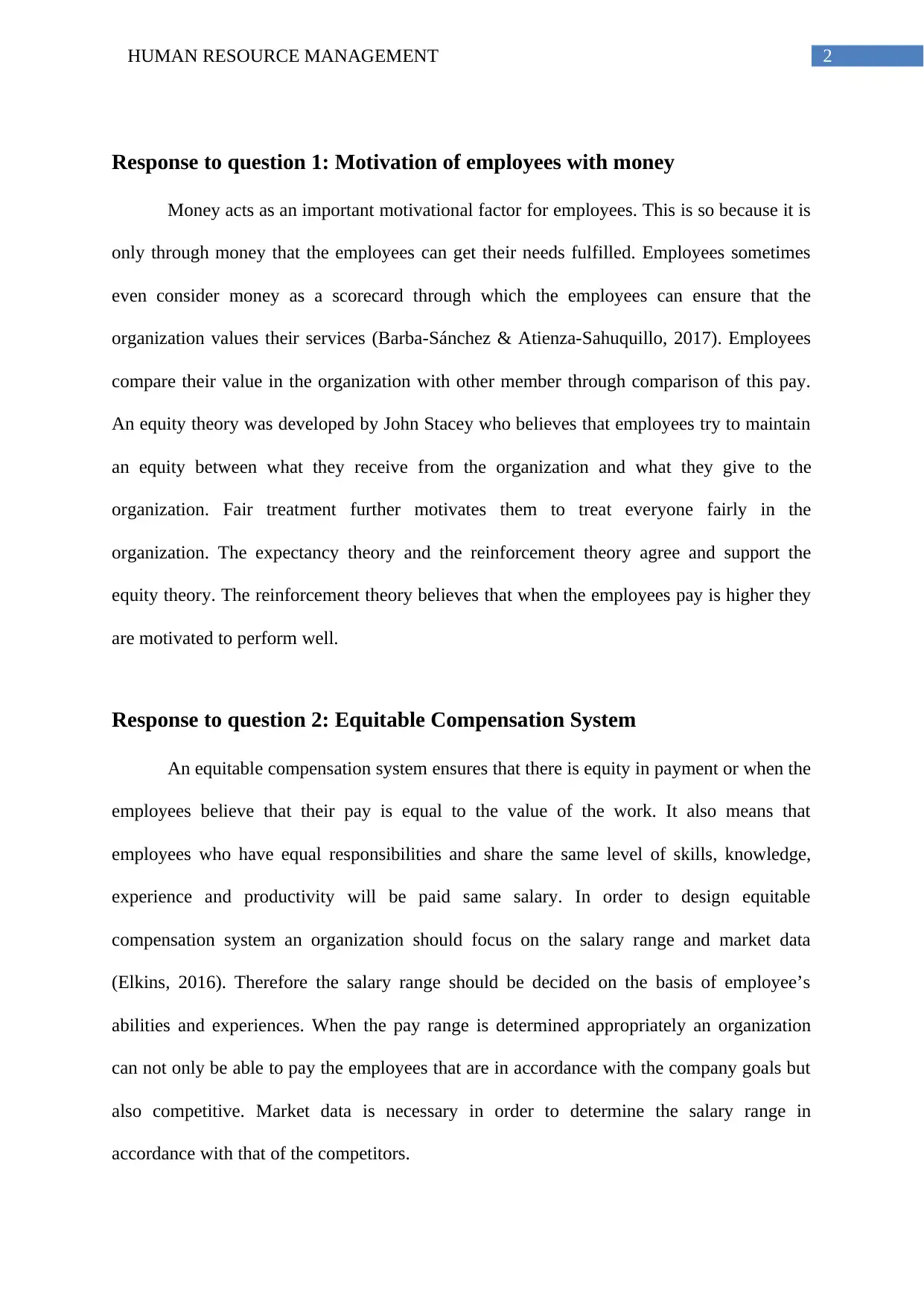
2HUMAN RESOURCE MANAGEMENT
Response to question 1: Motivation of employees with money
Money acts as an important motivational factor for employees. This is so because it is
only through money that the employees can get their needs fulfilled. Employees sometimes
even consider money as a scorecard through which the employees can ensure that the
organization values their services (Barba-Sánchez & Atienza-Sahuquillo, 2017). Employees
compare their value in the organization with other member through comparison of this pay.
An equity theory was developed by John Stacey who believes that employees try to maintain
an equity between what they receive from the organization and what they give to the
organization. Fair treatment further motivates them to treat everyone fairly in the
organization. The expectancy theory and the reinforcement theory agree and support the
equity theory. The reinforcement theory believes that when the employees pay is higher they
are motivated to perform well.
Response to question 2: Equitable Compensation System
An equitable compensation system ensures that there is equity in payment or when the
employees believe that their pay is equal to the value of the work. It also means that
employees who have equal responsibilities and share the same level of skills, knowledge,
experience and productivity will be paid same salary. In order to design equitable
compensation system an organization should focus on the salary range and market data
(Elkins, 2016). Therefore the salary range should be decided on the basis of employee’s
abilities and experiences. When the pay range is determined appropriately an organization
can not only be able to pay the employees that are in accordance with the company goals but
also competitive. Market data is necessary in order to determine the salary range in
accordance with that of the competitors.
Response to question 1: Motivation of employees with money
Money acts as an important motivational factor for employees. This is so because it is
only through money that the employees can get their needs fulfilled. Employees sometimes
even consider money as a scorecard through which the employees can ensure that the
organization values their services (Barba-Sánchez & Atienza-Sahuquillo, 2017). Employees
compare their value in the organization with other member through comparison of this pay.
An equity theory was developed by John Stacey who believes that employees try to maintain
an equity between what they receive from the organization and what they give to the
organization. Fair treatment further motivates them to treat everyone fairly in the
organization. The expectancy theory and the reinforcement theory agree and support the
equity theory. The reinforcement theory believes that when the employees pay is higher they
are motivated to perform well.
Response to question 2: Equitable Compensation System
An equitable compensation system ensures that there is equity in payment or when the
employees believe that their pay is equal to the value of the work. It also means that
employees who have equal responsibilities and share the same level of skills, knowledge,
experience and productivity will be paid same salary. In order to design equitable
compensation system an organization should focus on the salary range and market data
(Elkins, 2016). Therefore the salary range should be decided on the basis of employee’s
abilities and experiences. When the pay range is determined appropriately an organization
can not only be able to pay the employees that are in accordance with the company goals but
also competitive. Market data is necessary in order to determine the salary range in
accordance with that of the competitors.
⊘ This is a preview!⊘
Do you want full access?
Subscribe today to unlock all pages.

Trusted by 1+ million students worldwide
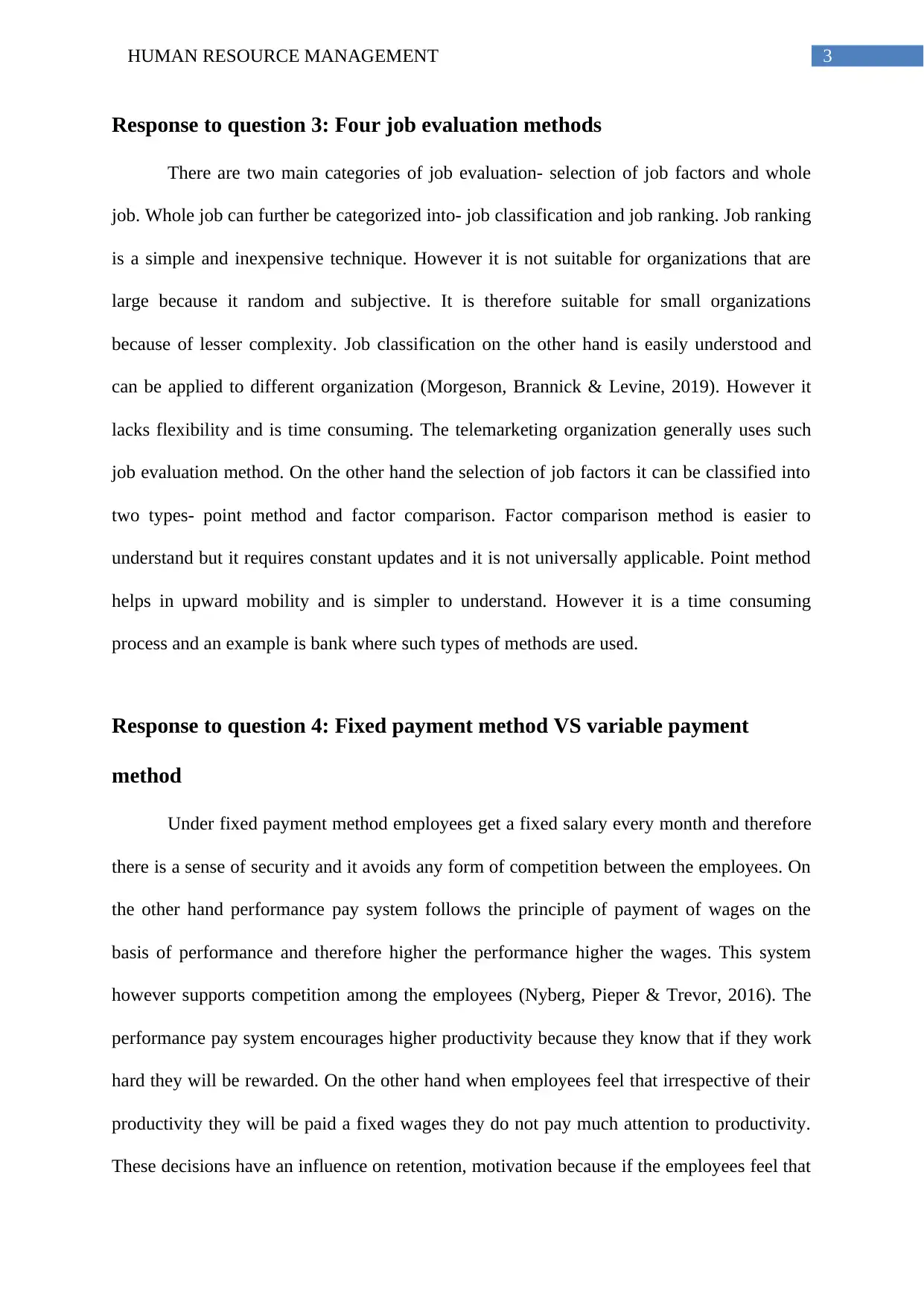
3HUMAN RESOURCE MANAGEMENT
Response to question 3: Four job evaluation methods
There are two main categories of job evaluation- selection of job factors and whole
job. Whole job can further be categorized into- job classification and job ranking. Job ranking
is a simple and inexpensive technique. However it is not suitable for organizations that are
large because it random and subjective. It is therefore suitable for small organizations
because of lesser complexity. Job classification on the other hand is easily understood and
can be applied to different organization (Morgeson, Brannick & Levine, 2019). However it
lacks flexibility and is time consuming. The telemarketing organization generally uses such
job evaluation method. On the other hand the selection of job factors it can be classified into
two types- point method and factor comparison. Factor comparison method is easier to
understand but it requires constant updates and it is not universally applicable. Point method
helps in upward mobility and is simpler to understand. However it is a time consuming
process and an example is bank where such types of methods are used.
Response to question 4: Fixed payment method VS variable payment
method
Under fixed payment method employees get a fixed salary every month and therefore
there is a sense of security and it avoids any form of competition between the employees. On
the other hand performance pay system follows the principle of payment of wages on the
basis of performance and therefore higher the performance higher the wages. This system
however supports competition among the employees (Nyberg, Pieper & Trevor, 2016). The
performance pay system encourages higher productivity because they know that if they work
hard they will be rewarded. On the other hand when employees feel that irrespective of their
productivity they will be paid a fixed wages they do not pay much attention to productivity.
These decisions have an influence on retention, motivation because if the employees feel that
Response to question 3: Four job evaluation methods
There are two main categories of job evaluation- selection of job factors and whole
job. Whole job can further be categorized into- job classification and job ranking. Job ranking
is a simple and inexpensive technique. However it is not suitable for organizations that are
large because it random and subjective. It is therefore suitable for small organizations
because of lesser complexity. Job classification on the other hand is easily understood and
can be applied to different organization (Morgeson, Brannick & Levine, 2019). However it
lacks flexibility and is time consuming. The telemarketing organization generally uses such
job evaluation method. On the other hand the selection of job factors it can be classified into
two types- point method and factor comparison. Factor comparison method is easier to
understand but it requires constant updates and it is not universally applicable. Point method
helps in upward mobility and is simpler to understand. However it is a time consuming
process and an example is bank where such types of methods are used.
Response to question 4: Fixed payment method VS variable payment
method
Under fixed payment method employees get a fixed salary every month and therefore
there is a sense of security and it avoids any form of competition between the employees. On
the other hand performance pay system follows the principle of payment of wages on the
basis of performance and therefore higher the performance higher the wages. This system
however supports competition among the employees (Nyberg, Pieper & Trevor, 2016). The
performance pay system encourages higher productivity because they know that if they work
hard they will be rewarded. On the other hand when employees feel that irrespective of their
productivity they will be paid a fixed wages they do not pay much attention to productivity.
These decisions have an influence on retention, motivation because if the employees feel that
Paraphrase This Document
Need a fresh take? Get an instant paraphrase of this document with our AI Paraphraser
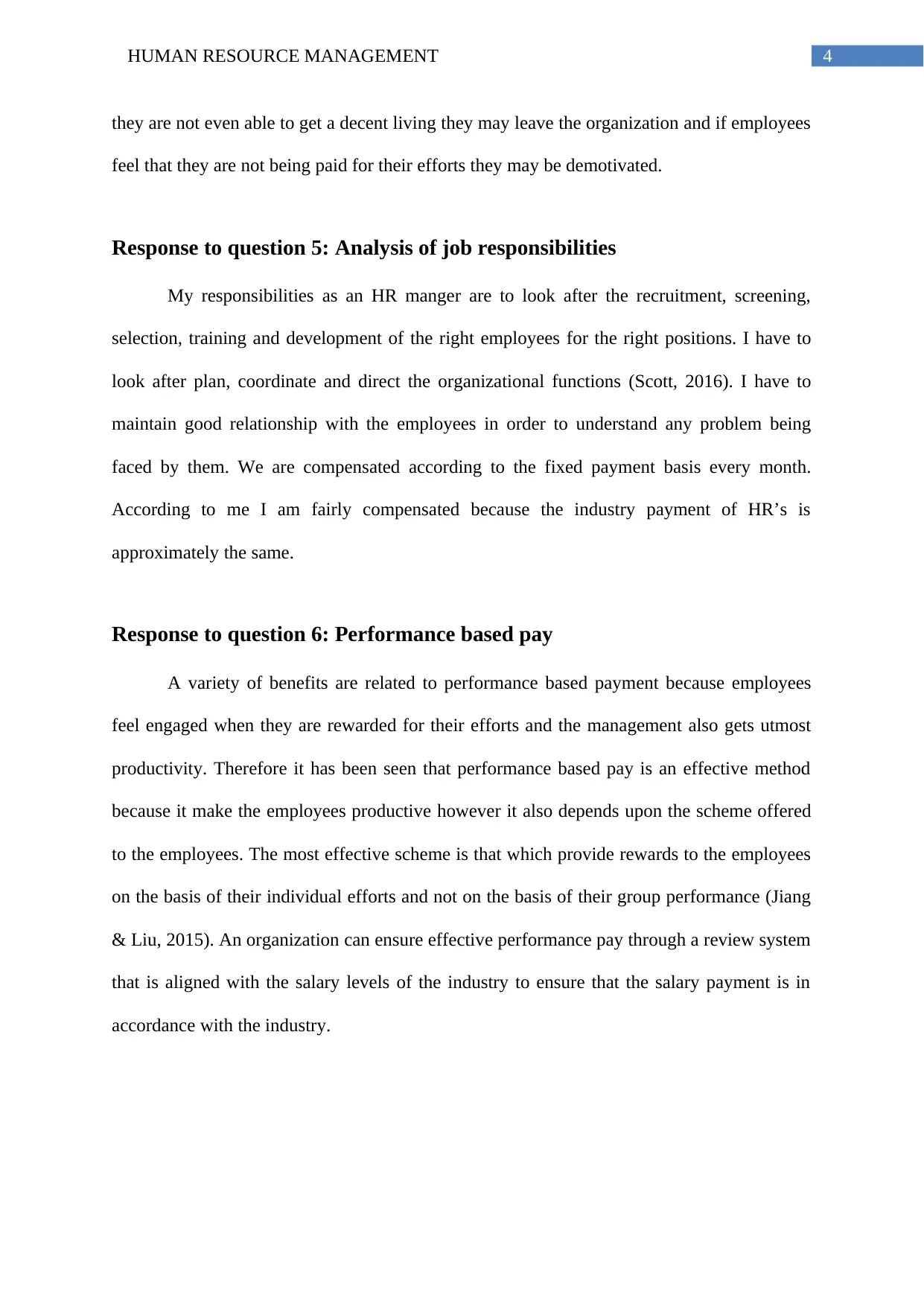
4HUMAN RESOURCE MANAGEMENT
they are not even able to get a decent living they may leave the organization and if employees
feel that they are not being paid for their efforts they may be demotivated.
Response to question 5: Analysis of job responsibilities
My responsibilities as an HR manger are to look after the recruitment, screening,
selection, training and development of the right employees for the right positions. I have to
look after plan, coordinate and direct the organizational functions (Scott, 2016). I have to
maintain good relationship with the employees in order to understand any problem being
faced by them. We are compensated according to the fixed payment basis every month.
According to me I am fairly compensated because the industry payment of HR’s is
approximately the same.
Response to question 6: Performance based pay
A variety of benefits are related to performance based payment because employees
feel engaged when they are rewarded for their efforts and the management also gets utmost
productivity. Therefore it has been seen that performance based pay is an effective method
because it make the employees productive however it also depends upon the scheme offered
to the employees. The most effective scheme is that which provide rewards to the employees
on the basis of their individual efforts and not on the basis of their group performance (Jiang
& Liu, 2015). An organization can ensure effective performance pay through a review system
that is aligned with the salary levels of the industry to ensure that the salary payment is in
accordance with the industry.
they are not even able to get a decent living they may leave the organization and if employees
feel that they are not being paid for their efforts they may be demotivated.
Response to question 5: Analysis of job responsibilities
My responsibilities as an HR manger are to look after the recruitment, screening,
selection, training and development of the right employees for the right positions. I have to
look after plan, coordinate and direct the organizational functions (Scott, 2016). I have to
maintain good relationship with the employees in order to understand any problem being
faced by them. We are compensated according to the fixed payment basis every month.
According to me I am fairly compensated because the industry payment of HR’s is
approximately the same.
Response to question 6: Performance based pay
A variety of benefits are related to performance based payment because employees
feel engaged when they are rewarded for their efforts and the management also gets utmost
productivity. Therefore it has been seen that performance based pay is an effective method
because it make the employees productive however it also depends upon the scheme offered
to the employees. The most effective scheme is that which provide rewards to the employees
on the basis of their individual efforts and not on the basis of their group performance (Jiang
& Liu, 2015). An organization can ensure effective performance pay through a review system
that is aligned with the salary levels of the industry to ensure that the salary payment is in
accordance with the industry.
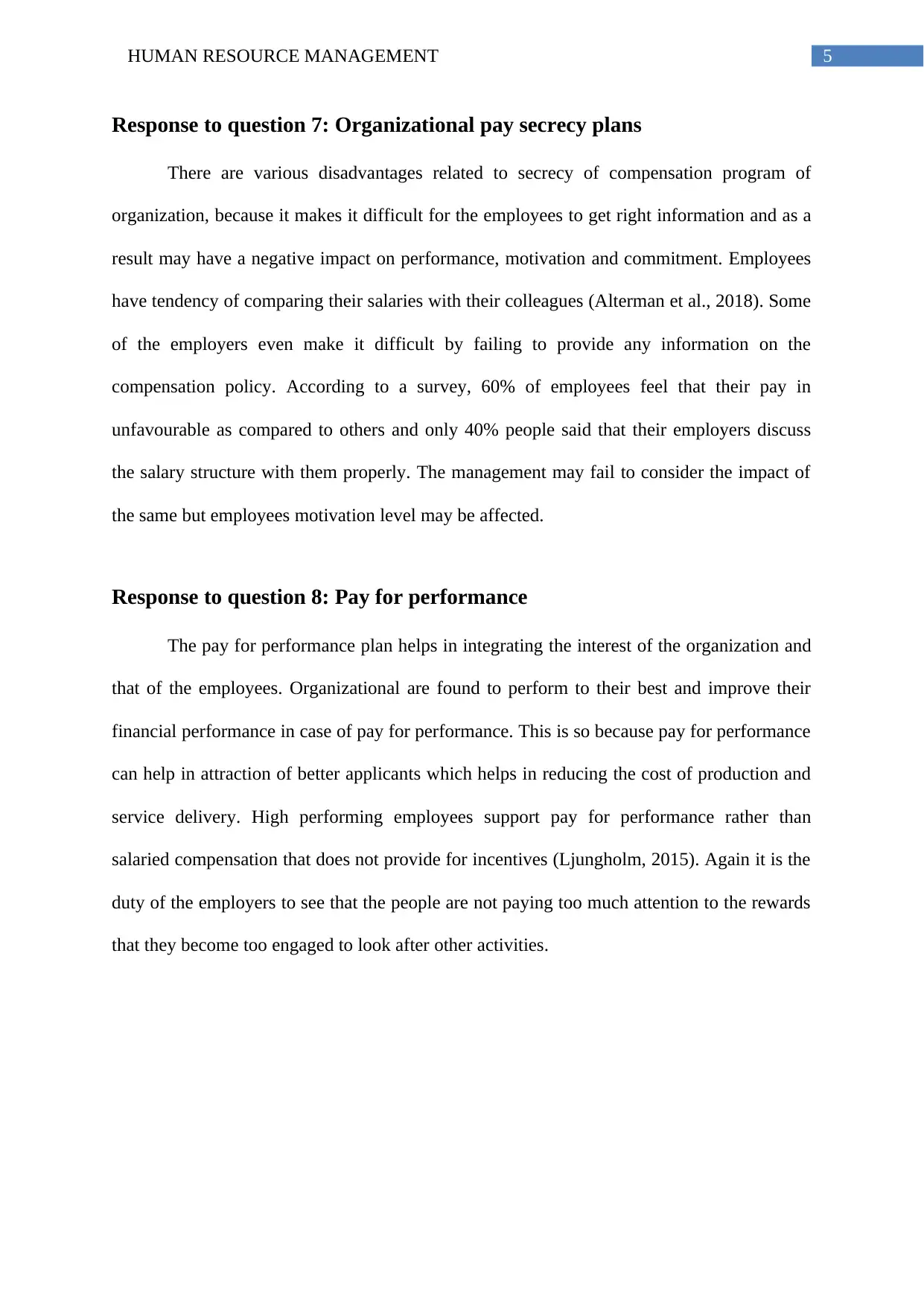
5HUMAN RESOURCE MANAGEMENT
Response to question 7: Organizational pay secrecy plans
There are various disadvantages related to secrecy of compensation program of
organization, because it makes it difficult for the employees to get right information and as a
result may have a negative impact on performance, motivation and commitment. Employees
have tendency of comparing their salaries with their colleagues (Alterman et al., 2018). Some
of the employers even make it difficult by failing to provide any information on the
compensation policy. According to a survey, 60% of employees feel that their pay in
unfavourable as compared to others and only 40% people said that their employers discuss
the salary structure with them properly. The management may fail to consider the impact of
the same but employees motivation level may be affected.
Response to question 8: Pay for performance
The pay for performance plan helps in integrating the interest of the organization and
that of the employees. Organizational are found to perform to their best and improve their
financial performance in case of pay for performance. This is so because pay for performance
can help in attraction of better applicants which helps in reducing the cost of production and
service delivery. High performing employees support pay for performance rather than
salaried compensation that does not provide for incentives (Ljungholm, 2015). Again it is the
duty of the employers to see that the people are not paying too much attention to the rewards
that they become too engaged to look after other activities.
Response to question 7: Organizational pay secrecy plans
There are various disadvantages related to secrecy of compensation program of
organization, because it makes it difficult for the employees to get right information and as a
result may have a negative impact on performance, motivation and commitment. Employees
have tendency of comparing their salaries with their colleagues (Alterman et al., 2018). Some
of the employers even make it difficult by failing to provide any information on the
compensation policy. According to a survey, 60% of employees feel that their pay in
unfavourable as compared to others and only 40% people said that their employers discuss
the salary structure with them properly. The management may fail to consider the impact of
the same but employees motivation level may be affected.
Response to question 8: Pay for performance
The pay for performance plan helps in integrating the interest of the organization and
that of the employees. Organizational are found to perform to their best and improve their
financial performance in case of pay for performance. This is so because pay for performance
can help in attraction of better applicants which helps in reducing the cost of production and
service delivery. High performing employees support pay for performance rather than
salaried compensation that does not provide for incentives (Ljungholm, 2015). Again it is the
duty of the employers to see that the people are not paying too much attention to the rewards
that they become too engaged to look after other activities.
⊘ This is a preview!⊘
Do you want full access?
Subscribe today to unlock all pages.

Trusted by 1+ million students worldwide
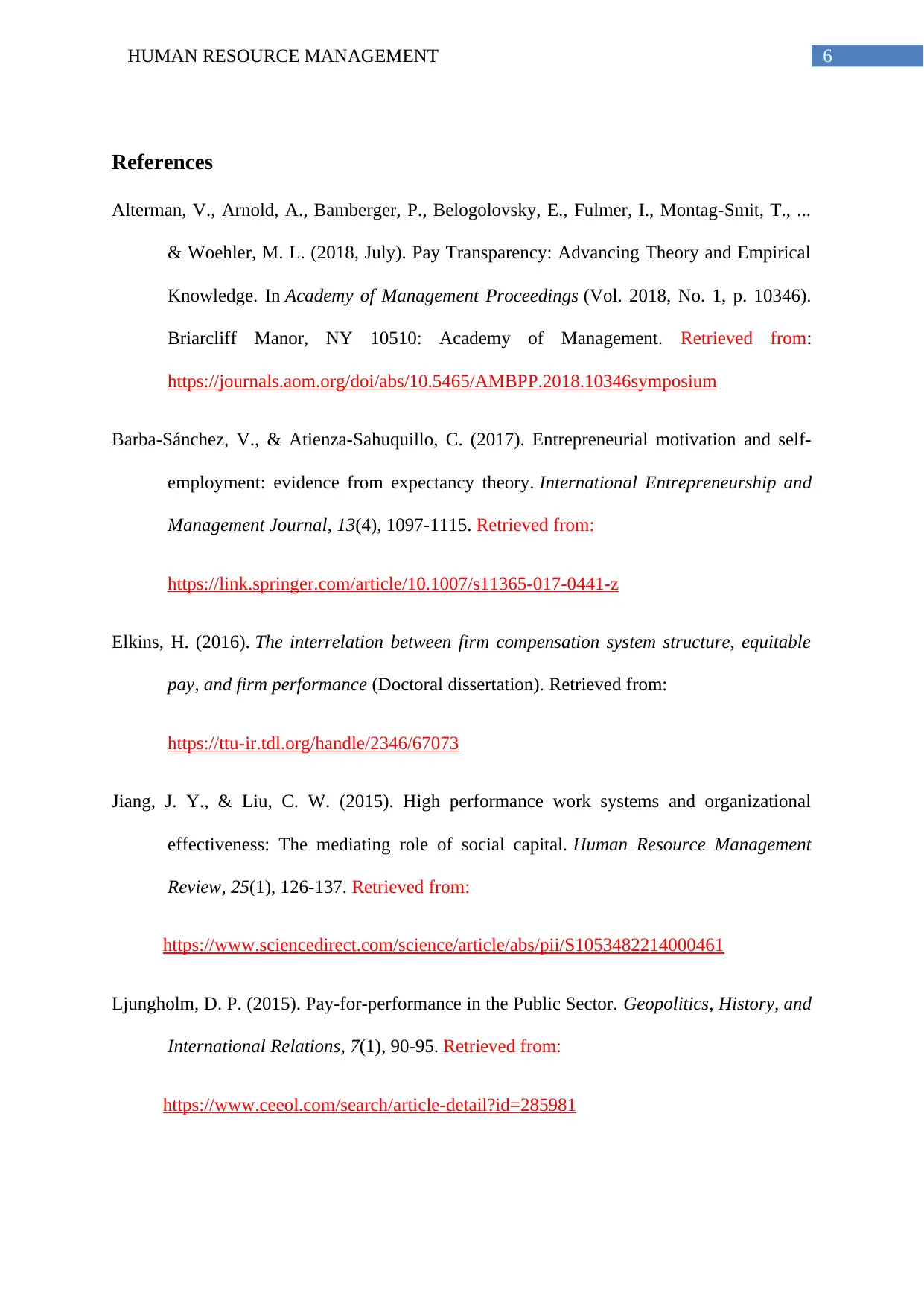
6HUMAN RESOURCE MANAGEMENT
References
Alterman, V., Arnold, A., Bamberger, P., Belogolovsky, E., Fulmer, I., Montag-Smit, T., ...
& Woehler, M. L. (2018, July). Pay Transparency: Advancing Theory and Empirical
Knowledge. In Academy of Management Proceedings (Vol. 2018, No. 1, p. 10346).
Briarcliff Manor, NY 10510: Academy of Management. Retrieved from:
https://journals.aom.org/doi/abs/10.5465/AMBPP.2018.10346symposium
Barba-Sánchez, V., & Atienza-Sahuquillo, C. (2017). Entrepreneurial motivation and self-
employment: evidence from expectancy theory. International Entrepreneurship and
Management Journal, 13(4), 1097-1115. Retrieved from:
https://link.springer.com/article/10.1007/s11365-017-0441-z
Elkins, H. (2016). The interrelation between firm compensation system structure, equitable
pay, and firm performance (Doctoral dissertation). Retrieved from:
https://ttu-ir.tdl.org/handle/2346/67073
Jiang, J. Y., & Liu, C. W. (2015). High performance work systems and organizational
effectiveness: The mediating role of social capital. Human Resource Management
Review, 25(1), 126-137. Retrieved from:
https://www.sciencedirect.com/science/article/abs/pii/S1053482214000461
Ljungholm, D. P. (2015). Pay-for-performance in the Public Sector. Geopolitics, History, and
International Relations, 7(1), 90-95. Retrieved from:
https://www.ceeol.com/search/article-detail?id=285981
References
Alterman, V., Arnold, A., Bamberger, P., Belogolovsky, E., Fulmer, I., Montag-Smit, T., ...
& Woehler, M. L. (2018, July). Pay Transparency: Advancing Theory and Empirical
Knowledge. In Academy of Management Proceedings (Vol. 2018, No. 1, p. 10346).
Briarcliff Manor, NY 10510: Academy of Management. Retrieved from:
https://journals.aom.org/doi/abs/10.5465/AMBPP.2018.10346symposium
Barba-Sánchez, V., & Atienza-Sahuquillo, C. (2017). Entrepreneurial motivation and self-
employment: evidence from expectancy theory. International Entrepreneurship and
Management Journal, 13(4), 1097-1115. Retrieved from:
https://link.springer.com/article/10.1007/s11365-017-0441-z
Elkins, H. (2016). The interrelation between firm compensation system structure, equitable
pay, and firm performance (Doctoral dissertation). Retrieved from:
https://ttu-ir.tdl.org/handle/2346/67073
Jiang, J. Y., & Liu, C. W. (2015). High performance work systems and organizational
effectiveness: The mediating role of social capital. Human Resource Management
Review, 25(1), 126-137. Retrieved from:
https://www.sciencedirect.com/science/article/abs/pii/S1053482214000461
Ljungholm, D. P. (2015). Pay-for-performance in the Public Sector. Geopolitics, History, and
International Relations, 7(1), 90-95. Retrieved from:
https://www.ceeol.com/search/article-detail?id=285981
Paraphrase This Document
Need a fresh take? Get an instant paraphrase of this document with our AI Paraphraser
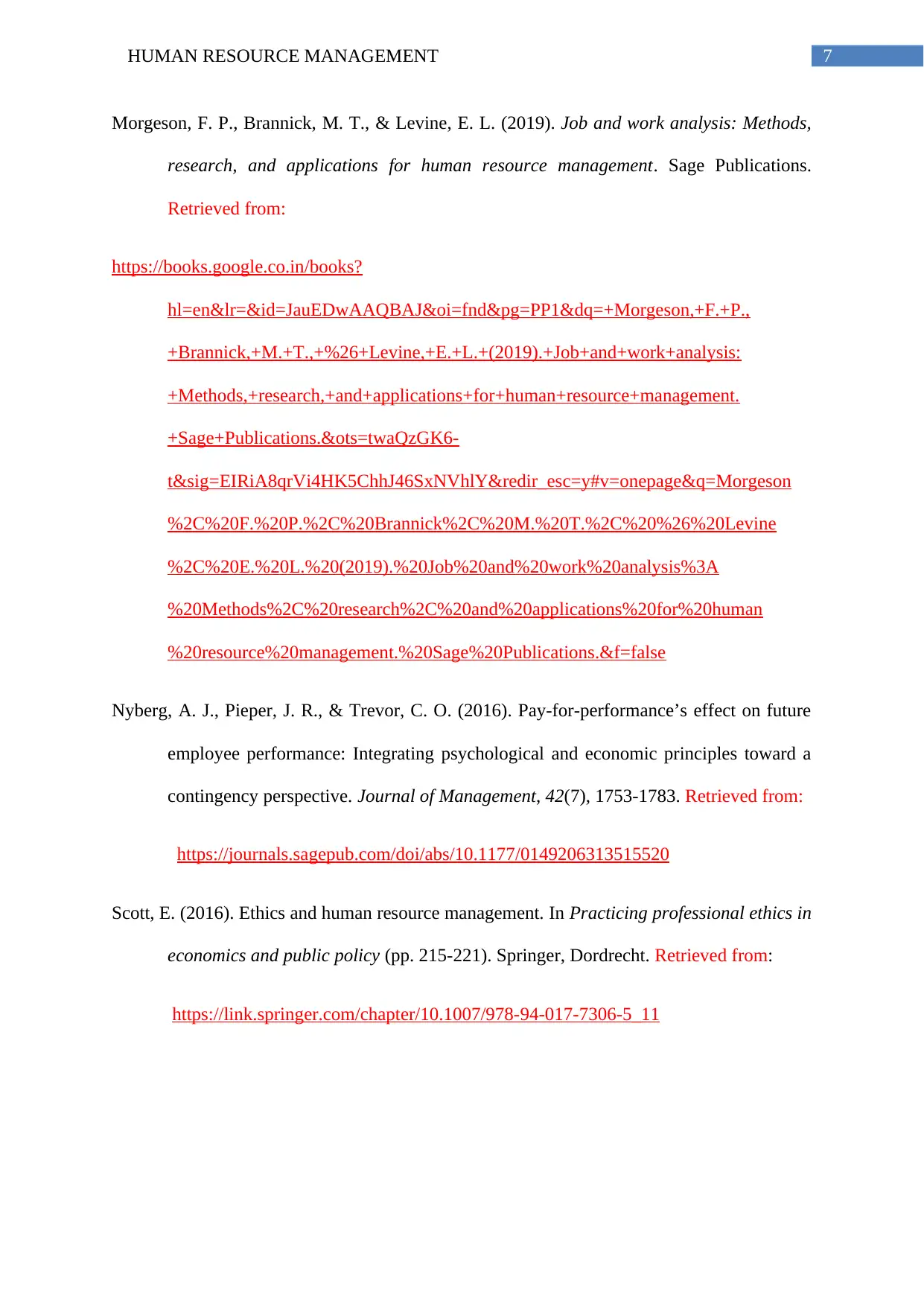
7HUMAN RESOURCE MANAGEMENT
Morgeson, F. P., Brannick, M. T., & Levine, E. L. (2019). Job and work analysis: Methods,
research, and applications for human resource management. Sage Publications.
Retrieved from:
https://books.google.co.in/books?
hl=en&lr=&id=JauEDwAAQBAJ&oi=fnd&pg=PP1&dq=+Morgeson,+F.+P.,
+Brannick,+M.+T.,+%26+Levine,+E.+L.+(2019).+Job+and+work+analysis:
+Methods,+research,+and+applications+for+human+resource+management.
+Sage+Publications.&ots=twaQzGK6-
t&sig=EIRiA8qrVi4HK5ChhJ46SxNVhlY&redir_esc=y#v=onepage&q=Morgeson
%2C%20F.%20P.%2C%20Brannick%2C%20M.%20T.%2C%20%26%20Levine
%2C%20E.%20L.%20(2019).%20Job%20and%20work%20analysis%3A
%20Methods%2C%20research%2C%20and%20applications%20for%20human
%20resource%20management.%20Sage%20Publications.&f=false
Nyberg, A. J., Pieper, J. R., & Trevor, C. O. (2016). Pay-for-performance’s effect on future
employee performance: Integrating psychological and economic principles toward a
contingency perspective. Journal of Management, 42(7), 1753-1783. Retrieved from:
https://journals.sagepub.com/doi/abs/10.1177/0149206313515520
Scott, E. (2016). Ethics and human resource management. In Practicing professional ethics in
economics and public policy (pp. 215-221). Springer, Dordrecht. Retrieved from:
https://link.springer.com/chapter/10.1007/978-94-017-7306-5_11
Morgeson, F. P., Brannick, M. T., & Levine, E. L. (2019). Job and work analysis: Methods,
research, and applications for human resource management. Sage Publications.
Retrieved from:
https://books.google.co.in/books?
hl=en&lr=&id=JauEDwAAQBAJ&oi=fnd&pg=PP1&dq=+Morgeson,+F.+P.,
+Brannick,+M.+T.,+%26+Levine,+E.+L.+(2019).+Job+and+work+analysis:
+Methods,+research,+and+applications+for+human+resource+management.
+Sage+Publications.&ots=twaQzGK6-
t&sig=EIRiA8qrVi4HK5ChhJ46SxNVhlY&redir_esc=y#v=onepage&q=Morgeson
%2C%20F.%20P.%2C%20Brannick%2C%20M.%20T.%2C%20%26%20Levine
%2C%20E.%20L.%20(2019).%20Job%20and%20work%20analysis%3A
%20Methods%2C%20research%2C%20and%20applications%20for%20human
%20resource%20management.%20Sage%20Publications.&f=false
Nyberg, A. J., Pieper, J. R., & Trevor, C. O. (2016). Pay-for-performance’s effect on future
employee performance: Integrating psychological and economic principles toward a
contingency perspective. Journal of Management, 42(7), 1753-1783. Retrieved from:
https://journals.sagepub.com/doi/abs/10.1177/0149206313515520
Scott, E. (2016). Ethics and human resource management. In Practicing professional ethics in
economics and public policy (pp. 215-221). Springer, Dordrecht. Retrieved from:
https://link.springer.com/chapter/10.1007/978-94-017-7306-5_11
1 out of 8
Related Documents
Your All-in-One AI-Powered Toolkit for Academic Success.
+13062052269
info@desklib.com
Available 24*7 on WhatsApp / Email
![[object Object]](/_next/static/media/star-bottom.7253800d.svg)
Unlock your academic potential
Copyright © 2020–2025 A2Z Services. All Rights Reserved. Developed and managed by ZUCOL.





